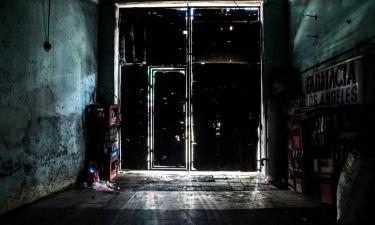New Evidence of Flowing Water on Mars
The Mars rover Spirit has developed a problem with one of its six wheels, but NASA officials said Tuesday they believe the robot geologist can continue working. The right front wheel has become balky, requiring more electrical current to turn, said Mark Adler, mission manager at NASA's Jet Propulsion Laboratory in Pasadena. Engineers are considering whether to simply continue using the wheel until it fails or drive on five wheels and use the problem wheel only when necessary. The Spirit rover also had a problem last week receiving commands from Earth. The communication problem was the result of cold temperatures, which caused the rover's receiver to drift out of the frequency range in which the commands were sent. The range was broadened, and the rover received commands after the loss of only one day of work, Adler said. Spirit is exploring the vast Gusev Crater region and has encountered strange rocks that cascaded down from nearby hills. Scientists are intrigued with images of a rock dubbed "Pot of Gold," which features round and football-shaped nodules in orderly groupings. Other photographs revealed what scientists called "rotting rocks." One resembles a decaying loaf of bread, its interior disintegrating and leaving a crust-like shell of material formed by an unknown process. "It's kind of difficult to imagine that somehow water wasn't involved, but it's too early to tell," said Larry Soderblom, a science team member from the U.S. Geological Survey in Flagstaff, Ariz. On the opposite side of Mars, Opportunity has entered a deep crater named Endurance to explore stratified rock that could open a window deeper into the geological history of the Red Planet, informs CBSNews. According to NYTimes, with one Mars rover climbing into the hills and the other descending deep into a crater, scientists yesterday reported the discovery of several mysterious rock structures along with yet more signs that Mars was once awash in water. Both rovers, the Spirit and the Opportunity, have more than doubled their intended lifetimes of three months. The extra time has allowed the Spirit, which is exploring the 95-mile-wide Gusev Crater, to reach hilly terrain about 1.5 miles from its landing site in search of exposed bedrock. Bedrock is more valuable for telling the geological history of a site than loose rocks and boulders that may have been carried there from elsewhere. At a news conference yesterday at NASA's Jet Propulsion Laboratory in Pasadena, Calif., Dr. Steven W. Squyres, the mission's principal investigator, said the Spirit had now "arrived at one of the best exposures of bedrock that we have found." Some parts of the bedrock appear "very clean and gray" while other parts are "light-toned and kind of crumbly and cruddy looking," Dr. Squyres said. The scientists hypothesize that the crumbly rock also started clean and gray, but underwent chemical transformations, perhaps from water. USATODAY reports that NASA's Mars rovers have uncovered more tantalizing evidence of a watery past on the Red Planet, scientists said Wednesday. And the rovers, Spirit and Opportunity, are continuing to do their jobs months after they were expected to die. Aside from minor complaints, such as a balky wheel on Spirit and a stone jamming a grinder on Opportunity, "both rovers are performing marvelously," says Chris Salvo of the Jet Propulsion Laboratory, which manages the mission. Salvo says engineers expect to remove the stone before the grinder is again needed by scientists. Both Mars rovers landed in January on an $835 million mission to search for signs of past water on the planet. Since a controversial report of fossilized microbes hidden inside a Martian meteorite emerged in 1996, scientists have pondered the possibility that life once existed on Mars, and water would have been a prerequisite for that. Gusev Crater was selected as Spirit's landing site because from space the crater appears to have been a lake at some point in its history. Team scientists said at a JPL briefing that Spirit has now climbed about 10 yards up a hillside, getting above the Gusev plain. Holes drilled into soft bedrock there show that, compared with the volcanic rocks below, there are higher amounts of elements that are active in water. Those elements may be evidence of the suspected lakebed. Opportunity, in contrast, has descended deep into one of the craters dotting Meridiani Planum, its landing region. "Wonderful layered rocks" exist there, says mission scientist Steve Squyres of Cornell University.
Read earlier news stories by PRAVDA.Ru.
Subscribe to Pravda.Ru Telegram channel, Facebook, RSS!




